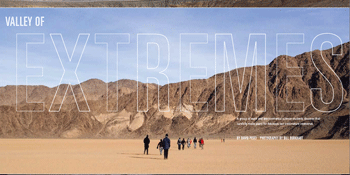Valley of Extremes
 IT ALL CAME DOWN TO THE WIND ON VENTIFACT RIDGE.
IT ALL CAME DOWN TO THE WIND ON VENTIFACT RIDGE.
The wind—thousands of years’ worth of sand-filled storms and sustained breezes blowing in excess of 50 miles per hour—had carved dramatic features into the solid rocks and outcropping throughout Death Valley. The geological term for these features is “ventifacts,” and some of the 13 earth and environmental science students who had traveled in mid-January from Middletown to the amazing geologic spectacle that is Death Valley had designed a field study to calculate the direction of the winds that had produced the ventifacts on Ventifact Ridge. The study was straightforward and scientifically sound. It involved some mapping, hands-on measurements, and observations. But there was one thing the students hadn’t figured on.
The wind.
“Oh. My. God,” said Maya Gomes ’06. “We had just gotten to the site and set up and suddenly this cold front rolled in and a 50-mile-an-hour wind just started blowing. And it wasn’t just a gust. It was a sustained sandstorm. It was like being sprayed by needles over and over. I never had so much sand in my hair, my things. It was pretty intense.”
“A lot of people lost their digital cameras,” says Gabriel Knight ’06, who covered up his exposed skin as best he could and put on field goggles to protect himself against the pelting sand. “Still, it was really interesting to see the difference in wind speed in relation to the sand sizes the wind could transport. I guess you have to be a geology nerd to really appreciate that. But I loved it.”
Even though it did make the field study much more difficult.
“That is part of the idea behind this trip,” says Martha Gilmore, assistant professor of earth and environmental sciences (E&ES) and one of the leaders of the seven-day field study in Death Valley. “You can read all the literature available and plan your fieldwork right down to the last detail. But when you get out there, it’s the conditions that will often dictate how much actual work you can get done.”
The trip is part of a new curriculum initiated by Gilmore and her E&ES colleagues last year.
“We wanted to give seniors a capstone course that would offer them significant, useful skills for those who want to become geologists or environmental scientists,” she says.
The year-long course involves a semester of classroom work that examines the whole of Earth history and includes discussion and presentation of topics in the primary literature. The course culminates with the design of original field studies aimed at a geological area formed during the Cenozoic Period (which began 65 million years ago and continues to the present day). The second semester involves a field trip to that area, carrying out the studies and analyzing and presenting the data generated–all made possible by the Harold T. Stearns Scholarship Fund for Geologic Study.
“What better place to study than Death Valley?” says Phillip Resor, assistant professor of earth and environmental science, who co-led the trip with Gilmore. “It’s a spectacular place. The valley itself formed in the Cenozoic and has active faults and volcanic craters, but some of the underlying bedrock is more than a billion years old. It was once a lake, but now it is a desert. All of these interesting and unique geologic features are completely exposed so that students can just look at a mountain and interpret its formation.”
Not to mention extreme weather including temperatures that range from as low as 15°F to in excess of 130°F. Oh yes, and the appearance of often powerful sustained winds.
Aside from the wind, the temperatures remained in the relatively hospitable 30 to 60°F range for the 13 students who accompanied Gilmore and Resor on the trip. The students had selected some of Death Valley’s more intriguing phenomena to study, which, along with the ventifacts, included examination of the booming sands. These are found in some giant dunes. When the sands are made to move, they emit a low-frequency sound that many have said resembles whale songs.
“Why they ‘boom’ is the question,” Gilmore says. “Theories extend to grain size, composition, relative dryness, and other characteristics. But when you hear it, it’s just awesome.”
The students recorded the sounds of the shifting sands and took samples and measurements for analysis.
Another interesting phenomenon investigated was the “sliding stones” of Racetrack Playa. These stones, some of which are more than a foot in diameter, create geometric trails behind them on the flat playa reminiscent of crop circles. How they do this is open to some debate.
“The stones are pushed along by wind, and the trails they create are consistent with mud or ice in the soil,” Resor says. “The patterns they leave on the playa floor can be quite dramatic.”
Many included right angles, sweeping curves, and doubling back.
“It was just amazing to see,” said Gomes. “The patterns were so beautiful.”
Time was spent examining desert varnish–a phenomenon that occurs with the combination of evaporating moisture and a baking sun for thousands of years. The students also examined volcanic craters, and the record of large ash falls and a magma release.
They will analyze data and observations over the coming months for formal presentations to peers and other faculty in the E&ES department, just as they would if they were working actively in geology or environmental science.
“Along with all the experience they’ve gained through this course, the students also got a good education in the realities of fieldwork,” says Gilmore. “Planning is essential, but a scientist has to learn to adapt to what nature gives you when you’re out there.”
That lesson seems to have been learned, but the week in Death Valley may have provided an even more important lesson that can’t be gleaned in the classroom.
“It was a great experience!” says Gomes. “I always loved fieldwork here in New England, but this trip has gotten me so excited to do more.”
Knight has similar sentiments.
“Working out in the field with people you’ve known for four years and professors who love what they do makes every day enjoyable,” he says. “A trip like this only solidifies even further that I really chose the perfect major for me. I absolutely loved it.”


